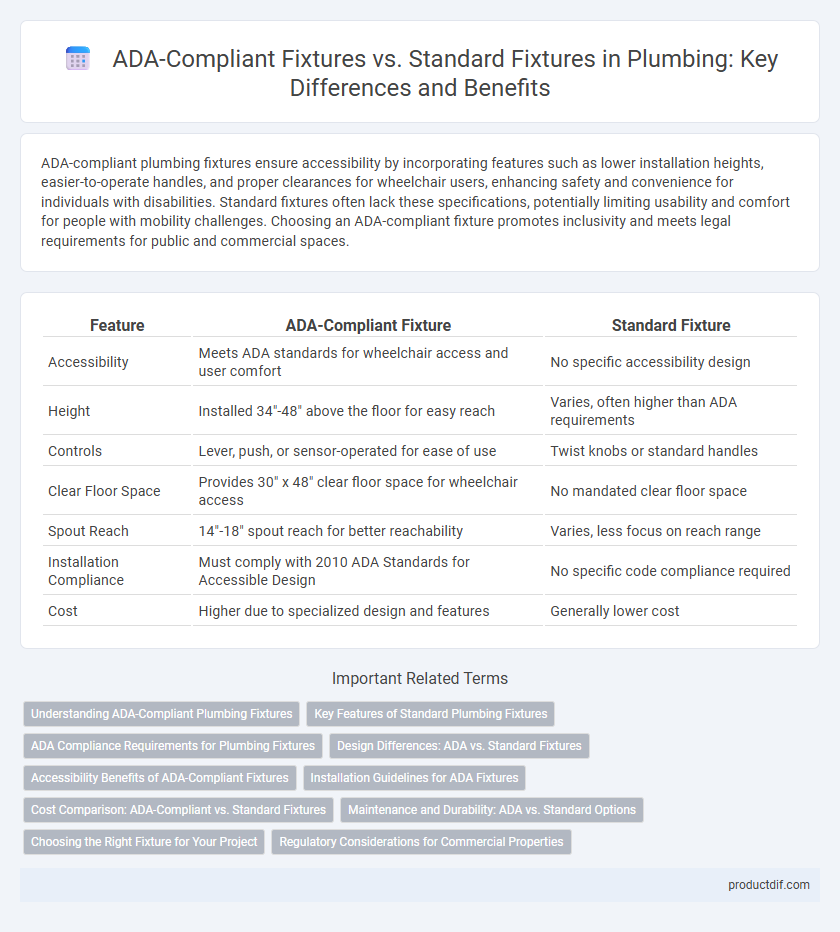ADA-compliant plumbing fixtures ensure accessibility by incorporating features such as lower installation heights, easier-to-operate handles, and proper clearances for wheelchair users, enhancing safety and convenience for individuals with disabilities. Standard fixtures often lack these specifications, potentially limiting usability and comfort for people with mobility challenges. Choosing an ADA-compliant fixture promotes inclusivity and meets legal requirements for public and commercial spaces.
Table of Comparison
| Feature | ADA-Compliant Fixture | Standard Fixture |
|---|---|---|
| Accessibility | Meets ADA standards for wheelchair access and user comfort | No specific accessibility design |
| Height | Installed 34"-48" above the floor for easy reach | Varies, often higher than ADA requirements |
| Controls | Lever, push, or sensor-operated for ease of use | Twist knobs or standard handles |
| Clear Floor Space | Provides 30" x 48" clear floor space for wheelchair access | No mandated clear floor space |
| Spout Reach | 14"-18" spout reach for better reachability | Varies, less focus on reach range |
| Installation Compliance | Must comply with 2010 ADA Standards for Accessible Design | No specific code compliance required |
| Cost | Higher due to specialized design and features | Generally lower cost |
Understanding ADA-Compliant Plumbing Fixtures
ADA-compliant plumbing fixtures are designed to meet the accessibility standards set by the Americans with Disabilities Act, ensuring features like appropriate height, lever handles, and clear floor space for wheelchair users. These fixtures differ from standard plumbing fixtures by incorporating ergonomic designs and specific dimensions that facilitate ease of use and safety for individuals with disabilities. Compliance with ADA guidelines improves public and commercial restroom accessibility, supporting inclusive design and legal adherence.
Key Features of Standard Plumbing Fixtures
Standard plumbing fixtures typically feature traditional designs without specialized modifications for accessibility, including standard-height sinks and toilets that do not accommodate users with mobility impairments. These fixtures often have conventional lever or knob handles that require fine motor skills and strength, which may not meet ADA requirements. Materials used in standard fixtures are chosen primarily for durability and aesthetics rather than the enhanced usability and safety features found in ADA-compliant models.
ADA Compliance Requirements for Plumbing Fixtures
ADA-compliant plumbing fixtures must meet specific requirements such as appropriate height, clear floor space, and operable parts that do not require tight grasping or twisting, ensuring accessibility for individuals with disabilities. Standard fixtures often lack these features, making them less accessible and non-compliant with ADA regulations outlined in the 2010 ADA Standards for Accessible Design. Key ADA specifications include fixture installation at heights between 17 to 19 inches for toilets and lever-operated faucets that accommodate limited hand mobility.
Design Differences: ADA vs. Standard Fixtures
ADA-compliant plumbing fixtures feature specific design elements such as lever handles, lower mounting heights, and increased clear floor space to ensure accessibility for individuals with disabilities. Standard fixtures often lack these adaptations, prioritizing traditional aesthetics and installation heights without mandated accessibility considerations. The focus on ergonomic operation and spatial accommodation in ADA fixtures differentiates them significantly from conventional plumbing designs.
Accessibility Benefits of ADA-Compliant Fixtures
ADA-compliant plumbing fixtures enhance accessibility by featuring lever handles, lower height installation, and clear floor space, ensuring ease of use for individuals with disabilities. These fixtures meet the Americans with Disabilities Act standards, providing improved usability for wheelchair users and those with limited dexterity. Standard fixtures typically lack these modifications, limiting access and convenience for people with mobility challenges.
Installation Guidelines for ADA Fixtures
ADA-compliant plumbing fixtures require specific installation guidelines to ensure accessibility, such as mounting heights between 17 to 19 inches from the floor to the fixture rim and providing clear floor space of at least 30 by 48 inches for wheelchair access. These fixtures must also have lever-operated, push-type, or electronically controlled faucets to accommodate users with limited hand mobility. In contrast, standard fixtures lack these precise requirements and may be installed at varying heights and without accessibility considerations.
Cost Comparison: ADA-Compliant vs. Standard Fixtures
ADA-compliant plumbing fixtures typically cost 20-30% more than standard fixtures due to specialized design features that ensure accessibility for individuals with disabilities. The higher price reflects enhanced durability, ergonomics, and adherence to federal regulations such as the Americans with Disabilities Act (ADA). Choosing ADA-compliant fixtures often results in long-term savings by avoiding potential legal penalties and enhancing facility inclusivity.
Maintenance and Durability: ADA vs. Standard Options
ADA-compliant plumbing fixtures incorporate materials and designs that enhance durability while ensuring ease of maintenance for users with disabilities, featuring corrosion-resistant finishes and accessible components. Standard fixtures may offer a broader range of styles but often require more frequent upkeep due to less robust construction and limited accessibility features. Prioritizing ADA-compliant options can reduce maintenance costs and extend fixture lifespan through engineered resilience and user-friendly maintenance accessibility.
Choosing the Right Fixture for Your Project
Selecting an ADA-compliant plumbing fixture ensures accessibility and meets legal requirements for public and commercial spaces, while standard fixtures often prioritize cost and design variety. ADA fixtures feature specific dimensions, lever handles, and clear floor space for wheelchair users, enhancing safety and usability. Prioritize ADA-compliant fixtures in projects requiring inclusivity, code adherence, and functional design for all users.
Regulatory Considerations for Commercial Properties
ADA-compliant plumbing fixtures in commercial properties must meet specific standards outlined by the Americans with Disabilities Act, such as appropriate height, lever handles, and clear floor space for wheelchair access. Standard fixtures often do not fulfill these regulatory requirements, risking non-compliance penalties and exclusion from accessible design mandates. Ensuring ADA-compliance supports legal adherence, promotes inclusive use, and minimizes liability related to accessibility violations.
ADA-compliant Fixture vs Standard Fixture Infographic

 productdif.com
productdif.com